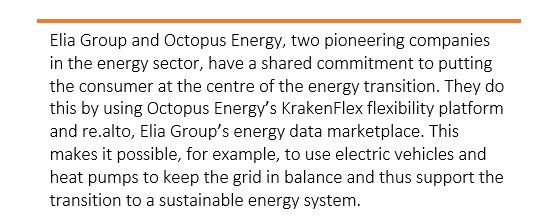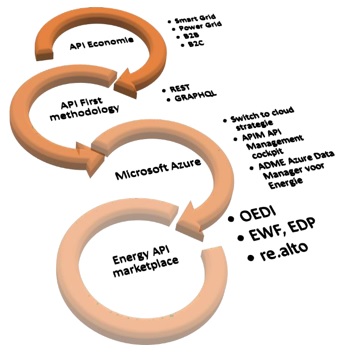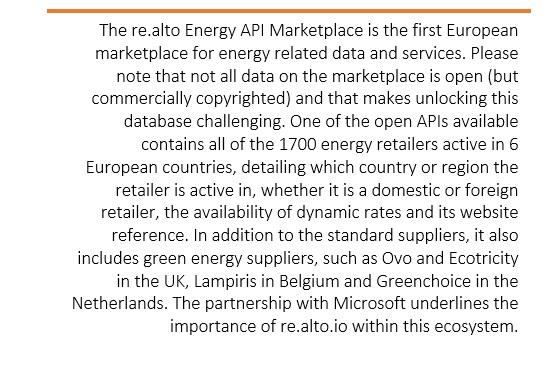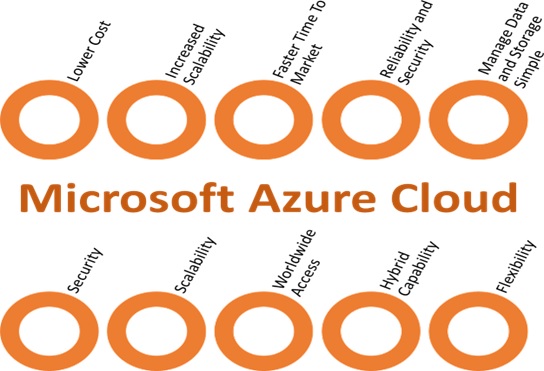The energy market is rapidly changing and this requires innovative solutions to accelerate the challenges of the energy transition. Naturally, this has a major impact on various players and market mechanisms. Both on the production and distribution side, but also on the delivery side. Partnerships are the cornerstone of this new ecosystem. Standardisation, scalability and flexibility are the new normal.
Our global energy market is facing major changes. The traditional model where electricity is centrally generated in a power plant and operated by a large utility company has changed into a more decentralised model dominated by renewable energy offered by often smaller players.
New small-scale energy players such as citizen cooperatives and energy communities, but also prosumers, consumers who also produce at the same time, have emerged and require a different approach.

Connectivity and data exchange is an essential part of the digital revolution in the energy market in the Netherlands. This data then makes it possible for supply and demand to be better predicted within a smart grid and for the stability of the distribution network or power grid to be guaranteed.
In a decentralised energy landscape, with large solar installations, wind turbines, electric cars, heat pumps and also battery storage systems, millions of those connected points need to be aligned in order to make their data available.
In many areas, this represents a major paradigm shift. The conventional model, where electrical systems are centrally managed, is being challenged by the decentralised generation of renewable energy. Due to their exponential growth and often less controllable nature, this literally and figuratively puts strain on existing supply systems. To guarantee a stable distribution network, energy storage is important, dynamic models are being introduced and better coordination between supply and demand is necessary. After all, creating decentralised units creates collective intelligence. By means of bi-directional communication between the various parties, in open data formats and in real-time, it is possible to better respond to the new dynamics between supply and demand.
It is clear that existing services and business models need to be redesigned. The current power and smart grids need to be adapted to such far-reaching flexibility. Naturally, this offers opportunities for new players in that market, but it also gives existing stakeholders the opportunity to develop new services.

Accelerating launching services through an API-first architecture
Unlike a classic code-first approach, where developers first develop code and later figure out how that software can communicate with other systems, a modern and open API architecture starts with the interface or the bridge. The focus is on designing and building the programming interfaces and only then on effectively developing the application. In this way, products can be built quickly and safely that are both future-proof and easily scalable.
In addition to the benefits of flexibility and agility, an API-first architecture also offers another major advantage, namely lower development costs because the same APIs and coding can be used over and over again on different projects. The design resolves most issues before code is written, which also allows development teams to work in parallel.
The cockpit for API lifecycle management
With its focus on specific industry segments such as utilities and energy companies, Microsoft builds strong ecosystems that enable developers and system integrators to build modular and reusable applications.
Companies and service providers can therefore bring smart products and digital services to the market more quickly. Automation continues to accelerate APIs and application developments. The benefits of speed, efficiency and self-service are clear. However, the danger lies in duplication of code or building redundant APIs. An important component is API management. Microsoft APIM was selected in 2021 by Gartner and recognised as a leader in its Magic Quadrant™ for Full Lifecycle API Management.

With APIM, the Microsoft Azure API management platform, you can easily build a cockpit to monitor and manage the complete API portfolio. This allows developers to build applications faster and customers receive direct added value.
Through API imitation, front and backend teams are separately linked, API revisions and versions are easy to track, and it allows you to build a central and automated API documentation library. API Management also helps import, manage, secure, test, publish and monitor GraphQL APIs.

The benefits of an API economy
Exchanging data and services using APIs allows faster product development, increases customer satisfaction, provides access to new markets and offers better collaboration opportunities, as well as many other benefits. Such an API-first approach fits perfectly within the concept of an API economy.

However, an API economy is not a technical concept, nor is it a financial model. It is the foundation of a strong ecosystem, where data and digital services are exchanged in a standardised way through APIs. Despite the fact that a company can already be fully API-driven internally, the primary focus of an API economy is on B2C and B2B. A classic example is the cloud itself.
Microsoft Azure is nothing less than a collection of APIs that provide access to their underlying infrastructure and applications.
To develop such an ecosystem as a company, technological choices must be made. Access to data, to distributed data, requires good preparation and a different approach. The choice of APIs to use, access to an industrial API marketplace and the use of a cloud platform determine this accessibility.
Traditionally, REST APIs are often used. This is the most commonly used API model, designed to work with HTTP protocols. REST APIs are easy to understand and implement and are suitable for small to medium-sized projects and are supported by most programming languages.
Today, companies are increasingly turning to GraphQL (although this still remains a small minority) because this API query language offers a more efficient, powerful and flexible approach to designing APIs. It also ensures a uniform interface for retrieving data from different sources and is also very flexible in retrieving a selection of data points from a larger data lake.

In addition to the choice of the API, it is also important to be able to rely on a relevant API marketplace. This speeds up the search for data sources, makes accessing them easy and supports their integration. Such an energy API marketplace focuses specifically on the various players within the energy sector, including solution developers, renewable energy producers, traditional utilities and traders.
On the one hand, there are initiatives such as Open Energy Data (OEDI) in the United States, with multiple data lakes and data sets, but also European initiatives such as the Energy Web Foundation (EWF) and EDP (European Data Portal) with more than 1300 data sets that enable access to public open energy data.
On the other hand, cross-industry API marketplaces such as re.alto.io (which, by the way, is built on the basis of APIM – Azure API Management) offer additional data sets such as weather information, IOT data, wind and solar production data, spot energy prices, e-mobility data and smart meter data. This makes integration a lot easier and speeds up the development process.
As a business model, companies can not only share their data on a marketplace for free but can also sell it or make it available via a subscription. This makes it easy to collect real-time data from wind and solar farms, for example, making it possible to quickly respond to changing weather. Moreover, this data can be used afterwards to make the prediction models more accurate.
The energy API marketplace for digital energy products
An API Marketplace is a database that collects APIs and makes them available for accelerated and standardised access to real-time data and various datasets. An energy API marketplace provides direct access to data from energy suppliers, e-mobility and EV charging data, market prices and forecasts, sun, wind and weather information and forecasts, grids and systems, imbalance information, smart meter data, as well as data from IoT and Smart Cities.
By offering a cross-border list in an API format, it becomes possible to find digital energy products in a simple and clear way and to connect to them via APIs.

Within an API economy, built around future-oriented APIs and an energy API marketplace, the various parties in the energy value chain can directly benefit from its advantages, and it accelerates the development of new digital energy solutions and services.
The marketplace itself offers a range of options to quickly and easily put together new products without in-depth technical knowledge.
This way, different parties can work together without having to draw up lengthy cooperation agreements and negotiate partnerships.
As an example: The re.alto API marketplace was used at the Elia hackathons in Brussels and Berlin, so that professional IT teams could offer working solutions to tackle the energy transition in 3 days.
Microsoft Azure Data Manager for energy services
With ADME, Azure Data Manager for Energy, Microsoft enables energy companies to gain actionable insights, improve operational efficiency, and also accelerate time to market on the cloud-based OSDU data platform. This supports innovation with a flexible and open platform on which developers can quickly build applications and adapt them flexibly.

Azure Data Manager for Energy (ADME) is a vendor-agnostic, open data platform that integrates with virtually any data set, application or cloud service.
ADME helps reduce the time, risk and costs of energy exploration and production by integrating with virtually any energy data set, application or cloud service with built-in tools. Management for compute-intensive workloads can be deployed on a global scale. All this in compliance with the OSDU Technical Standard for open-source innovation.
Implementing ADME accelerates data ingestion for analysis and decision-making. It provides additional insights so that additional actions can be taken quickly and increases operational efficiency, thereby reducing operational costs.

Access to data is more important than having data.
It is therefore necessary to build an architecture that serves as a collaborative platform, enabling scalable and flexible collaboration. A Microsoft Azure cloud architecture forms the basis of such an open data platform.
IT technology serves the right business expectations and enables them to develop new products, solutions and services more quickly. This requires far-reaching optimisation of the data infrastructure and simplified access to the available decentralised data points.

An on-premise IT architecture is a traditional way of managing IT systems, where all hardware, software and data are located at a central location within the organisation itself. This has the advantage that the organisation has maximum control over its own IT infrastructure, but the major disadvantage is that this infrastructure is often expensive, complex and rigid. All central and core processes run on this. Exchanging data, via old API standards, CSV files and FTP file transfer, is often manual or semi-automatic and therefore time-consuming.
It should be clear that a cloud architecture (in this specific case) is more secure. To achieve the same level of security on on-premise systems, which still have to communicate with the outside world, you have to take many costs into account. Of course, on-premise software that doesn’t have to communicate with anything is even more secure, but how long can these systems be maintained? Moreover, this kind of API first architecture guarantees more control. With an APIM, you can see at any time what is running, what is not running and where problems may arise. The entire setup becomes clearer and less difficult to manage. By introducing a cloud architecture, a modern way of managing IT systems, where all hardware, software and data are located on servers that are rented from external providers, those obstacles disappear. With a cloud solution, you can enjoy lower costs, higher performance and more flexibility. The dependence on the availability and security of the external provider is absorbed by the correct SLA agreements.
Microsoft Azure Cloud forms the foundation
Today, most companies are convinced of the many benefits of a cloud-based IT architecture. Through a Microsoft Azure cloud infrastructure and the additional tools offered by Microsoft, the connection of distributed energy assets can be accelerated and becomes extremely scalable and efficient. For players in the energy market, the transition from on-premise IT to a cloud architecture offers a number of direct business benefits:
– Accelerate the go-to-market of new services. The scalability of the cloud environment and the ready-to-use software components offered in an energy API marketplace make development and testing faster.
– Existing services can be adapted or expanded. A modular software architecture can easily be connected or disconnected via the API cloud interfaces.
– Dynamically respond to changing customer demands or market situations by using elastic software capacity. This can be scaled up or down automatically according to needs.
– Make more efficient use of data flows, such as better weather forecasts, insight into wind and solar energy generation and dynamic energy prices.
Scalability, standardisation and new services are the new normal. The challenges of a changing energy market are therefore best met by developing an adapted underlying cloud infrastructure that is scalable and dynamic and also allows for greater flexibility.
With Microsoft Azure as the foundation, a switch-to-cloud strategy is used to avoid creating data swamps. (The swamp of data abundance that no one wants to drown in.) To achieve this, the data must be intelligent, reliable and easily accessible.
The more robust building blocks for the new energy API economy are formed by a layer of future-oriented APIs supplemented by the associated API marketplace. This makes it possible to respond dynamically and predictably to supply and demand, by using collective data and by exchanging data in a standardised manner.
Such an architecture makes it possible for the various parties to create insights into their own rhythm and needs and to additionally design new business models.
Partnering with Microsoft also has additional advantages because as a company you can rely on a strongly developed ecosystem, a professional network of local partners and an international range of services for support and implementation.